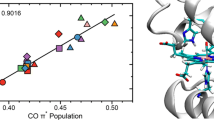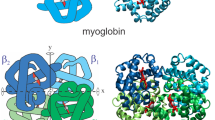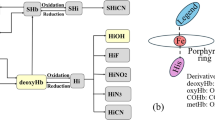Abstract
The heme-AB binding energies (AB = CO, O2) in a wild-type myoglobin (Mb) and two mutants (H64L, V68N) of Mb have been investigated in detail with both DFT and dispersion-corrected DFT methods, where H64L and V68N represent two different, opposite situations. Several dispersion correction approaches were tested in the calculations. The effects of the local protein environment were accounted for by including the five nearest surrounding residues in the calculated systems. The specific role of histidine-64 in the distal pocket was examined in more detail in this study than in other studies in the literature. Although the present calculated results do not change the previous conclusion that the hydrogen bonding by the distal histidine-64 residue plays a major role in the O2/CO discrimination by Mb, more details about the interaction between the protein environment and the bound ligand have been revealed in this study by comparing the binding energies of AB to a porphyrin and the various myoglobins. The changes in the experimental binding energies from one system to another are well reproduced by the calculations. Without constraints on the residues in geometry optimization, the dispersion correction is necessary, since it improves the calculated structures and energetic results significantly.



Similar content being viewed by others
Notes
In fact, we do not need to consider BSSE in the present calculations at all because we do not calculate intermolecular binding energies in this work.
The crystal coordinates are not the experimental raw data; they are a product of an involved series of model building, crystallographic refinement, manual examination, and rebuilding, possibly involving mistakes in interpretation.
Previous calculations with all-electron method (ref. [56]) or with an increased accuracy of the numerical integration (ref. [66]) could give FeP(4-EtIm)-AB binding energies which are somewhat larger than the present ones. Owing to error cancellations, the present calculated results are actually in closer agreement with experiment than the previous ones.
References
Stryer L (1981) Biochemistry, 4th edn. Freeman, New York
Collman JP, Brauman JI, Halbert TR, Suslick KS (1976) Nature of O2 and CO binding to metalloporphyrins and heme proteins. Proc Natl Acad Sci USA 73:3333–3337
Kuriyan J, Wilz S, Karplus M, Petsko GA (1986) X-ray structure and refinement of carbon- monoxy (Fe II)-myoglobin at 1.5 Å resolution. J Mol Biol 192:133–154
Cheng X-D, Schoenborn BP (1991) Neutron diffraction study of carbonmonoxymyoglobin. J Mol Biol 220:381–399
Kachalova GS, Popov AN, Bartunik HD (1999) A steric mechanism for inhibition of CO binding to heme proteins. Science 284:473–476
Vojtechovsky J, Chu K, Berendzen J, Sweet RM, Schlichting I (1999) Crystal structures of myoglobin-ligand complexes at near-atomic resolution. Biophys J 77:2153–2174
Lim M-H, Jackson TA, Anfinrud PA (1995) Binding of CO to myoglobin from a heme pocket docking site to form nearly linear Fe-C-O. Science 269:962–966
Ivanov D, Sage JT, Keim M, Powell JR, Asher SA (1994) Determination of CO orientation in myoglobin by single-crystal infrared linear dichroism. J Am Chem Soc 116:4139–4140
Kozlowski PM, Vogel KM, Zgierski MZ, Spiro TG (2001) Steric contributions to CO binding in heme proteins: a density functional analysis of FeCO vibrations and deformability. J Porph Phthal 5:312–322
McMahon MT, deDios AC, Godbout N, Salzmann R, Laws DD, Le H-B, Havlin RH, Oldfield E (1998) An experimental and quantum chemical investigation of CO binding to heme proteins and model systems: a unified model based on 13C, 17O, and 57Fe nuclear magnetic resonance and 57Fe moessbauer and infrared spectroscopies. J Am Chem Soc 120:4784–4797
Springer BA, Sligar SG, Olson JS, Phillips GN (1994) Mechanisms of ligand recognition in myoglobin. Chem Rev 94:699–714
Phillips SEV, Schoenborn BP (1981) Neutron diffraction reveals oxygen-histidine hydrogen bond in oxymyoglobin. Nature 292:81–82
Lukin JA, Simplaceanu V, Zou M, Ho NT, Ho C (2000) NMR reveals hydrogen bonds between oxygen and distal histidines in oxyhemoglobin. Proc Natl Acad Sci USA 97:10354–10358
Sigfridsson E, Ryde U (1999) On the significance of hydrogen bonds for the discrimination between CO and O2 by myoglobin. J Biol Inorg Chem 4:99–110
Sigfridsson E, Ryde U (2002) Theoretical study of the discrimination between O2 and CO by myoglobin. J Inorg Biochem 91:101–115
Edwards WD, Weiner B, Zerner MC (1986) On the low-lying states and electronic spectroscopy of iron(II) porphine. J Am Chem Soc 108:2196–2204
Waleh A, Ho N, Chantranupong L, Loew GH (1989) Electronic structure of nitrosyl ferrous heme complexes. J Am Chem Soc 111:2767–2772
Case DA, Huynh BH, Karplus M (1979) Binding of oxygen and carbon monoxide to hemoglobin. An analysis of the ground and excited states. J Am Chem Soc 101:4433–4453
Hoffmann R, Chen MML, Thorn DL (1977) Qualitative discussion of alternative coordination modes of diatomic ligands in transition metal complexes. Inorg Chem 16:503–511
Rovira C, Kunc K, Hutter J, Ballone P, Parrinello M (1997) Equilibrium geometries and electronic structure of iron-porphyrin complexes: a density functional study. J Phys Chem A 101:8914–8925
Rovira C, Parrinello M (1999) Factors influencing ligand-binding properties of heme models: a first principles study of picket-fence and protoheme complexes. Chem Eur J 5:250–262
Vogel KM, Kozlowski PM, Zgierski MZ, Spiro TG (1999) Determinants of the FeXO (X = C, N, O) vibrational frequencies in heme adducts from experiment and density functional theory. J Am Chem Soc 121:9915–9921
Vogel KM, Kozlowski PM, Zgierski MZ, Spiro TG (2000) Role of the axial ligand in heme- CO backbonding; DFT analysis of vibrational data. Inorg Chim Acta 297:11–17
Rovira C, Parrinello M (2000) Harmonic and anharmonic dynamics of Fe-CO and Fe-O2 in heme models. Biophys J 78:93–100
Rovira C, Schulze B, Eichinger M, Evanseck JD, Parrinello M (2001) Influence of the heme pocket conformation on the structure and vibrations of the Fe-CO bond in myoglobin: a QM/MM density functional study. Biophys J 81:435–445
Blomberg LM, Blomberg MRA, Siegbahn PEM (2005) A theoretical study on the binding of O2, NO and CO to heme proteins. J Inorg Biochem 99:949–958
De Angelis F, Jarzecki AA, Car R, Spiro TG (2005) Quantum chemical evaluation of protein control over heme ligation: CO/O2 discrimination in myoglobin. J Phys Chem B 109:3065–3070
Strickland N, Mulholland AJ, Harvey JN (2006) The Fe-CO bond energy in myoglobin: a QM/MM study of the effect of tertiary structure. Biophys J 90:L27–L29
Scherlis DA, Cococcioni M, Sit P, Marzari N (2007) Simulation of heme using DFT + U: a step toward accurate spin-state energetics. J Phys Chem B 111:7384–7391
Strickland N, Harvey JN (2007) Spin-forbidden ligand binding to the ferrous-heme group: ab initio and DFT studies. J Phys Chem B 111:841–852
Chen H, Ikeda-Saito M, Shaik S (2008) Nature of the Fe-O2 bonding in oxy-myoglobin: effect of the protein. J Am Chem Soc 130:14778–14790
Siegbahn PEM, Blomberg MRA, Chen S-L (2010) Significant van der Waals effects in transition metal complexes. J Chem Theory Comput 6:2040–2044
Cole DJ, O’Regan DD, Payne MC (2012) Ligand discrimination in myoglobin from linear-scaling DFT + U. J Phys Chem Lett 3:1448–1452
Olson JS, Phillips GN (1997) Myoglobin discriminates between O2, NO, and CO by electrostatic interactions with the bound ligand. J Biol Inorg Chem 2:544–552
Krzywda S, Murshudov GN, Brzozowski AM, Jaskolski M, Scott EE, Klizas SA, Gibson QH, Olson JS, Wilkinson AJ (1998) Stabilizing bound O2 in myoglobin by Valine68 (E11) to asparagine substitution. Biochemistry 37:15896–15907
Draghi F, Miele AE, Travaglini-Allocatelli C, Vallone B, Brunori M, Gibson QH, Olson JS (2002) Controlling ligand binding in myoglobin by mutagenesis. J Biol Chem 277:7509–7519
Coyle CM, Vogel KM, Rush TS, Kozlowski PM, Williams R, Spiro TG, Dou Y, Ikeda-Saito M, Olson JS, Zgierski MZ (2003) FeNO structure in distal pocket mutants of myoglobin based on resonance Raman spectroscopy. Biochemistry 42:4896–4903
Kundu S, Blouin GC, Premer SA, Sarath G, Olson JS, Hargrove MS (2004) Tyrosine B10 inhibits stabilization of bound carbon monoxide and oxygen in soybean leghemoglobin. Biochemistry 43:6241–6252
Chen O, Groh S, Liechty A, Ridge DP (1999) Binding of nitric oxide to iron(II) porphyrins: radiative association, blackbody infrared radiative dissociation and gas-phase association equilibrium. J Am Chem Soc 121:11910–11911
Momenteau M, Reed CA (1994) Synthetic heme-dioxygen complexes. Chem Rev 94:659–698
Spiro TG, Kozlowski PM (2001) Is the CO adduct of myoglobin bent, and does it matter? Acc Chem Res 34:137–144
Jung Y, Head-Gordon M (2006) A fast correlated electronic structure method for computing interaction energies of large van der Waals complexes applied to the fullerene-porphyrin dimer. Phys Chem Chem Phys 8:2831–2840
Sinnokrot MO, Sherrill CD (2006) High-accuracy quantum mechanical studies of pi-pi interactions in benzene dimers. J Phys Chem A 110:10656–10668
Hesselmann A, Jansen G, Schütz M (2005) Density-functional theory-symmetry-adapted intermolecular perturbation theory with density fitting: a new efficient method to study intermolecular interaction energies. J Chem Phys 122:14103–14120
Grimme S (2004) Accurate description of van der Waals complexes by density functional theory including empirical corrections. J Comput Chem 25:1463–1473
Riley KE, Pitonak M, Jurecka P, Hobza P (2010) Stabilization and structure calculations for noncovalent interactions in extended molecular systems based on wave function and density functional theories. Chem Rev 110:5023–5063
Liao M-S, Huang M-J, Watts JD (2012) Assessment of dispersion corrections in DFT calculations on large biological systems. Mol Phys 110:3061–3076. doi:10.1080/00268976.2012.695811
Grimme S, Antony J, Ehrlich S, Krieg H (2010) A consistent and accurate ab initio parametrization of density functional dispersion correction (DFT-D) for the 94 elements H-Pu. J Chem Phys 132:154104–1-25
Grimme S, Ehrlich S, Goerigk L (2011) Effect of the damping function in dispersion corrected density functional theory. J Comput Chem 32:1456–1465
Steinmann SN, Corminboeuf C (2011) Comprehensive benchmarking of a density- dependent dispersion correction. J Chem Theory Comput 7:3567–3577
Springer BA, Egeberg KD, Slighar SG, Rohlfs RJ, Mathews AJ, Olson JC (1989) Discrimination between oxygen and carbon monoxide and inhibition of autooxidation by myoglobin. Site-directed mutagenesis of the distal histidine. J Biol Chem 264:3057–3060
Radon M, Pierloot K (2008) Binding of CO, NO, and O2 to heme by density functional and multireference ab initio calculations. J Phys Chem A 112:11824–11832
Traylor TG, Stynes DV (1980) Isocyanide binding to chelated protoheme. Kinetic criteria for distal steric effects in hemoproteins. J Am Chem Soc 102:5938–5939
Grimme S (2006) Semiempirical GGA-type density functional constructed with a long-range dispersion correction. J Comput Chem 27:1787–1799
Liao M-S, Watts JD, Huang M-J (2009) Dispersion-corrected DFT calculations on C60-porphyrin complexes. Phys Chem Chem Phys 11:4365–4374
Liao M-S, Huang M-J, Watts JD (2010) Iron porphyrins with different imidazole ligands – a theoretical comparative study. J Phys Chem A 114:9554–9569
Quillin ML, Arduini RM, Olson JS, Phillips GN (1993) High-resolution crystal structures of distal histidine mutants of sperm whale myoglobin. J Mol Biol 234:140–155
te Velde G, Bickelhaupt FM, van Gisbergen SJA, Fonseca-Guerra C, Baerends EJ, Snijders JG, Ziegler T (2001) Chemistry with ADF. J Comput Chem 22:931–967
ADF2012.01. SCM, Theoretical Chemistry, Vrije Universiteit, Amsterdam, Netherlands. See also (http://www.scm.com)
Becke AD (1988) Density-functional exchange-energy approximation with correct asymptotic behavior. Phys Rev A 38:3098–3100
Perdew JP (1986) Density-functional approximation for the correlation energy of the inhomogeneous electron gas. Phys Rev B 33:8822–8824
Perdew JP, Burke K, Ernzerhof M (1996) Generalized gradient approximation made simple. Phys Rev Lett 77:3865–3868
Zhang Y-K, Yang W-T (1998) Comment on “Generalized gradient approximation made simple”. Phys Rev Lett 80:890–890
Becke AD (1993) Density-functional thermochemistry.3. The role of exact exchange. J Chem Phys 98:5648–5652
Lee C, Yang WT, Parr RG (1988) Development of the colle-salvetti correlation-energy formula into a functional of the electron-density. Phys Rev B 37:785–789
Liao M-S, Huang M-J, Watts JD (2011) FeP(Im)-AB bonding energies evaluated with a large number of density functionals (P = porphine, Im = imidazole, AB = CO, NO, and O2). Mol Phys 109:2035–2048
Kannemann FO, Becke AD (2010) van der Waals interactions in density-functional theory: intermolecular complexes. J Chem Theory Comput 6:1081–1088
Tang KT, Toennies JP (1984) An improved simple model for the van der Waals potential based on universal damping functions for the dispersion coefficients. J Chem Phys 80:3726–3741
Barone V, Biczysko M, Pavone M (2008) The role of dispersion correction to DFT for modelling weakly bound molecular complexes in the ground and excited electronic states. Chem Phys 346:247–256
Ziegler T, Tschinke V, Baerends EJ, Snijders JG, Ravenek W (1989) Calculation of bond energies in compounds of heavy elements by a quasi-relativistic approach. J Phys Chem 93:3050–3056
Jameson GB, Molinaro FS, Ibers JA, Collman JP, Brauman JI, Rose E, Suslick KS (1980) Models for the active site of oxygen-binding hemoproteins. Dioxygen binding properties and the structures of (2-methylimidazole)-meso-tetra(alpha, alpha, alpha, alpha-o- pivalamidophenyl)porphyrinatoiron(II)-ethanol and its dioxygen adduct. J Am Chem Soc 102:3224–3237
Chai J-D, Head-Gordon M (2008) Long-range corrected hybrid density functionals with damped atom–atom dispersion corrections. Phys Chem Chem Phys 10:6615–6620
Acknowledgments
This work was supported by Award Number SC1-HL096018 from the National Heart, Lung, and Blood Institute. The content is solely the responsibility of the authors and does not necessarily represent the official views of the National Heart, Lung, and Blood Institute or the National Institutes of Health (NIH). The ADF calculations were run on a QuantumCube™ QS32-2800C computer from Parallel Quantum Solutions, LLC.
Author information
Authors and Affiliations
Corresponding author
Electronic supplementary material
Below is the link to the electronic supplementary material.
Supplementary material
Damping functions in the various DFT + Edisp methods employed in this paper. Calculated structural parameters for the iron porphyrins [FeP(4-EtIm), FeP(4-EtIm)(AB)] and the various myoglobins [MbAB, H64L(AB), V68N(AB)] (AB = CO, O2), together with available experimental (X-ray) crystal structural data. Calculated relative energies for selected states of FeP(Im) with the B3LYP functional from the literature and in this work. BP and B3LYP calculated FeP(Im)-AB bonding energies from the literature and in this work. Comparison of the calculated energies (Ebind, ΔEbind) with DFT and various DFT + Edisp methods (−D1, −D3, −D3(BJ), -dDsC). (PDF 230 kb)
Rights and permissions
About this article
Cite this article
Liao, MS., Huang, MJ. & Watts, J.D. Effects of local protein environment on the binding of diatomic molecules to heme in myoglobins. DFT and dispersion-corrected DFT studies. J Mol Model 19, 3307–3323 (2013). https://doi.org/10.1007/s00894-013-1864-2
Received:
Accepted:
Published:
Issue Date:
DOI: https://doi.org/10.1007/s00894-013-1864-2




